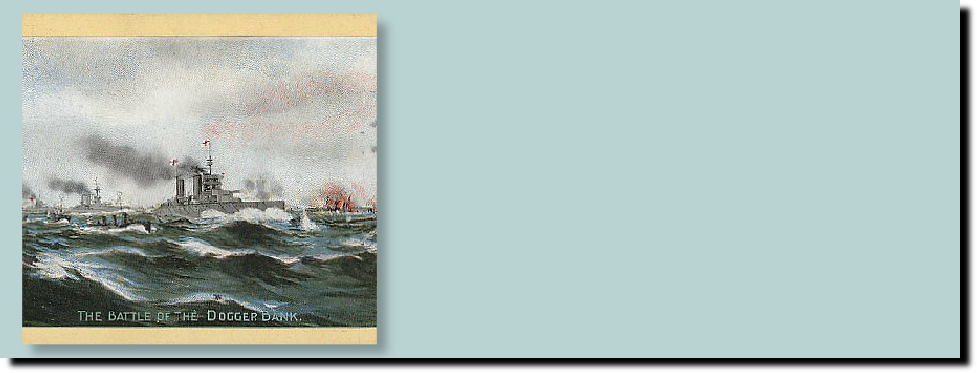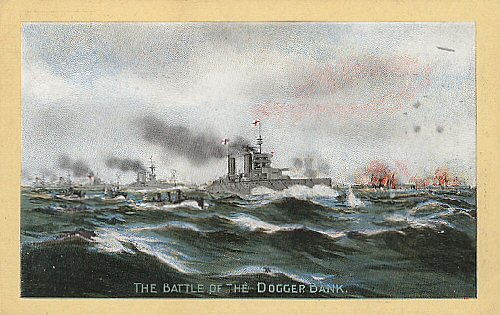
© Lindy and Martin Lovegrove 2012


At 4.45 pm (GMT) on the 23 January 1915 Rear-Admiral Hipper sailed from the Jade with the 1st and 2nd Scouting Groups of three battlecruisers, the large armoured cruiser Blücher and four light cruisers to scout the Dogger Bank region of the North Sea and attack any British light forces in the region.
Unfortunately the order to Hipper from Admiral von Ingenohl, head of the German navy,
was intercepted and decoded by the British Admiralty's deciphering service Room 40
and Vice-Admiral Beatty with his Rosyth based battlecruiser force and the Harwich
Force of light cruisers and destroyers under Commodore Tyrwhitt was ordered to rendezvous
at Dogger Bank at 7.00 am on the 24 January. The British units left port only minutes
after the German fleet.
At 7.14 am, just before daybreak, of 24 January the German light cruiser Kolberg on the portside of the German fleet sighted the light cruiser Aurora of the Harwich Force. Aurora challenged the German ship which opened fire scoring two hits, Aurora returned fire also scoring a couple of hits.
Hipper turned his heavy units towards the firing thinking that there were only light
enemy units in the area. Almost immediately on turning Stralsund saw the smoke form
Beatty's battlecruisers to the north-north-west. He decided to head for home and
so turned to the south-west at 7.35 am towards the German Bight. Hipper at first
thought they British ships were battleships, which he could easily outrun, but by
the time he realised that they were battlecruisers the range had already dropped
to 25,000 yards. The German line was in the order Seydlitz, Moltke, Derfflinger with
the large armoured cruiser Blucher last. The British pursued in a staggered line
a head formation with Lion leading followed by Tiger, Princess Royal and then the
slower New Zealand and Indomitable.
Blücher was the slowest German ship at 23 knots and along with some of the cola fired
torpedo boats slowed the German force down. Whilst the first three British battlecruisers
reached 27 knots, at one point Beatty ordered the impossible speed of 29 knots to
gee on his force, but the two older and slower battlecruisers of the 2nd Battlecruiser
Squadron gradually lagged behind, despite exceeding their trial speeds. The British
light forces attempted to get in a position to attack, but the speeds were too high,
and as the smoke they were generating was interfering with gunnery, Beatty ordered
them out of the way.
At 8.52 am Lion opened fire on Blücher but the range was too great, but by 9.00 am
Blücher was within range, 20,000 yards, and Lion commenced firing followed by Tiger
and Princess Royal, the first hits on Blücher being achieved at 9.09.
The Germans
returned fire at 9.11 concentrating on Lion. As the range closed New Zealand joined
the firing and Beatty ordered his ships to engage the corresponding ship in the enemy
line except Indomitable which was not in range. Unfortunately Tiger included Indomitable
in her calculations and so joined Lion firing on Seydlitz, leaving Moltke alone.
To compound her error Tiger mistook Lions fall of shot for her own making her aim
ineffective.
At 9.40 Lion scored a damaging hit on Seydlitz which penetrated the barbette of the
rear turret and set fire to some of the shell propellant. The flames rose into the
turret and through a connecting door, which should have been shut, to the second
turret killing the crews of both turrets, 159 men in total. Fortunately for Hipper
both magazines were flooded before things got any worse.
Lion was not having it all her own way as by now she had all three leading German
battlecruisers concentrating on her and she was repeatedly hit, the most serious
hit from Derfflinger causing her port water feed to be contaminated and within half
an hour her port engine had to be shut down. Blücher had taken heavy punishment and
her speed had dropped to 17 knots and was forced to drop out of the German line,
Beatty ordered the lagging Indomitable to intercept.
Lions speed was also dropping and she was about to be overtaken by Tiger and Princess
Royal. As this was happening a periscope was thought to be sighted from Lion, and
Beatty ordered a 90 degree turn to port at 10.58. This manoeuvre also had the effect
of forcing Hipper to cancel an attack he had just ordered by his torpedo boats. Once
clear of the perceived danger the order to change course to the north-east was given.
Beatty tried to signal Nelson's famous "Engage the enemy more closely" but this was
not in the signal book so "Attack the rear of the enemy" was substituted. Unfortunately
Lions wireless antenna were destroyed , her signal lamps had no power and all but
two of her signalling halyards had been shot away and a basic signalling error by
Beatty's flag-lieutenant Lieutenant-Commander Seymour meant that the signal was combined
with the course change to the north-east and so read "Attack the rear of the enemy,
bearing NE" - which was Blücher.
Beatty had to watch helplessly as his newly appointed second in command, Rear-Admiral
Moore in New Zealand, led the British force against the already doomed Blücher and
let the rest of the German force escape. Beatty transferred to the destroyer HMS
Attack in order to move to Princess Royal but by the time he achieved this the battle
was over.
The British ships finished off SMS Blücher, in the end she was hit by torpedoes from
Arethusa and destroyers, HMS Meteor being damaged by Blücher in the process. As Arethusa
was rescuing survivors a British stoker called 'Nobby' Clark was helping to haul
German sailors up over the side he was surprised to be greeted by a German with 'Hello
Nobby! Fancy meeting you here!' - it turned out that the German sailor had been his
next door neighbour in Hull before the start of world War 1. Whilst survivors were
being picked up the a seaplane and Zeppelin L5 bombed the operation, forcing the
abandonment of rescue efforts.
Aftermath of the Battle of Dogger Bank
After the battle the damaged Lion was towed home by Indomitable and did not return from repair until 9 April 1915, she had received sixteen hits. The only other British battlecruiser hit by heavy shells at Dogger Bank was Tiger which received six hits, a total of twenty-two hits from 900 heavy shells fired (Moltke 276, Seydlitz 390, Derfflinger 234). Blücher, as well as hitting the destroyer Meteor, also hit Lion once and Indomitable once, but caused the latter no damage. The British suffered fifteen killed and thirty-two wounded.
Apart from a large number on Blücher, only six hits were made on the other German
heavy units, three on Seydlitz and three on Derfflinger from 1152 heavy shells fired
(Indomitable 134, New Zealand 147, Lion 243, Princess Royal 273, Tiger 355). Derfflinger
was ready for sea again on 17 February and Seydlitz on 1 April. Total German casualties
were 954 killed, 80 wounded and 189 captured.
The British were publicly pleased with their undoubted victory at Dogger Bank although
in private both Beatty and the First Sea Lord Fisher were not happy that Moore had
let the rest of the German squadron escape. Although exonerated (he could hardly
be reprimanded for following orders), he was moved to the Canary Islands. Captain
Pelly of HMS Tiger was also criticised for the firing at the wrong target, the low
quality of his ships gunnery and for not pursing the Germans once Lion had dropped
out of the line. He was not removed as Tiger was a new ship which was not fully worked
up and Beatty felt Pelly would not make the same mistakes again. The action increased
Beatty's reputation but in private some considered he made a mistake in placing the
inexperience Tiger ahead of Princess Royal in the battle line and for overreacting
to the phantom submarine periscope.
Hipper was criticised for taking the slower Blücher
as part of their force but even once Blücher had been sunk his force was limited
to the same low speed by the limited speed of many of his coal powered torpedo boats,
making this criticism against Hipper a little unfair. There was strong criticism
of von Ingenhol for not supporting Hipper by using the battlefleet as a covering
force for the operation. The German Kaiser was furious with the defeat and ordered
fewer risks to be taken in the future. Admiral von Ingenhol was replaced with Admiral
Pohl as head of the navy.
The damage to Seydlitz ensured that the Germans reduced
the amount of shell propellant stored in the gun turrets to reduce the risk of explosion,
a lesson the British were not to learn until the Battle of Jutland. The British were
impressed with the quality of German shooting but not with the quality of their shell,
little did they realise that the British shells were even worse, and this problem
was not realised until the Battle of Jutland in 1916. Also HMS Lion found it hard
to return fire late in the battle because of the volume of fire she was under from
Moltke and Seydlitz, and so the British battlecruisers came to place too much emphasis
on high rates of fire, resulting in problems with accuracy and safety that showed
up at the Battle on Jutland in 1916.
The lessons that the British could have learnt,
about lack of initiative in subordinate commanders and signalling errors were not
learnt. Beatty stood by his flag lieutenant Seymour despite the fact that a previous
error by him had let a German squadron evade Beatty after a raid on the Yorkshire
coast, and mistakes at Jutland were to cause problems. Whilst loyalty to a subordinate
is desirable, surely Beatty took this too far for such an important position in the
flagship of such an important force.
Related Links:
Rear-Admiral Hipper
Blücher
Battle of Jutland
HMS New Zealand
HMS Indomitable
HMS Tiger
SMS Blücher
SMS Seydlitz
SMS Moltke
HMS Lion
HMS Tiger
The Battle
of Dogger Bank
The Battle Dogger Bank - 24 Jan 1915
